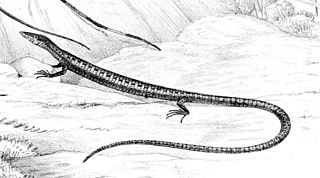 W
WAnadia ocellata, commonly known as the ocellated anadia , is a species of lizard endemic to the Americas.
 W
WBothrops pictus, commonly known in English as the desert lancehead, is a species of venomous snake in the family Viperidae. The species is endemic to South America.
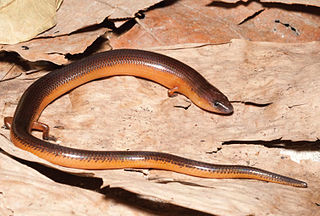 W
WBrachymeles bicolor, common name two-colored short-legged skink or elongate short-legged burrowing skink, is a species of skink endemic to Luzon, the Philippines. It is widely distributed through the island, at elevations of 250 to 850 m above sea level. However, its population is declining due to deforestation, and hence the species is classified as Near Threatened by the IUCN.
 W
WBradypodion ventrale, the southern dwarf chameleon, occurs in the Eastern Cape, South Africa. It is also known as the eastern Cape dwarf chameleon. It is a relatively large species of dwarf chameleon, reaching lengths of 14 cm (5.5 in). It has a very prominent casque on the back of its head and a long, beard-like throat crest. It lives in dense thickets and shrub, and is usually very difficult to spot because of its colouring. It adapts very well to living in suburban gardens, but domestic cats – being introduced predators – will usually kill all chameleons in the immediate area. Consequently, one should not bring chameleons into a garden which is frequented by cats. It gives birth to litters of between 10 and 20 babies in the summer.
 W
WBronchocela marmorata, marbled crested lizard, marbled bloodsucker or marbled agamid lizard is a species of lizard. It is endemic to the Philippines, where it inhabits lowland dipterocarp and montane forests at elevations 400 to 800 m above mean sea level. It is typically found on branches and leaves of trees. It feeds on insects and is oviparous, digging the soil to lay its eggs at the base of trees.
 W
WCalotes emma, commonly known as Emma Gray's forest lizard, is a species of lizard in the family Agamidae. The species is endemic to China, South Asia, and Southeast Asia.
 W
WChristinus marmoratus, also known as marbled gecko or marbled southern gecko, is a species of Gekkonidae (gecko) native to southern mainland of Australia, from Victoria to Western Australia. The species is well adapted to a variety of habitats, including city dwellings..
 W
WMenetia greyii, commonly known as the common dwarf skink, is a species of lizard in the family Scincidae. The species is endemic to mainland Australia.
 W
WCrenadactylus ocellatus, also known as the southwestern clawless gecko or western clawless gecko, is the smallest species of nocturnal Gekkonidae (gecko) found in Australia.
 W
WCtenophorus ornatus, the ornate crevice-dragon, is a species of lizard in the family Agamidae. It is found on granite outcrops of Western Australia.
 W
WCtenophorus reticulatus, the western netted dragon or western netted ground-dragon, is a species of lizard in the family Agamidae. It is found in South Australia, Western Australia and southern Northern Territory.
 W
WThe bar-shouldered ctenotus is a species of skink found in the Northern Territory, Queensland, and Western Australia.
 W
WDraco maculatus, commonly known as the spotted flying dragon, is a species of agamid flying lizard endemic to Southeast Asia. It is capable of gliding from tree to tree.
 W
WThe broad-banded sand-swimmer or Richardson’s skink is a species of skink found in Australia.
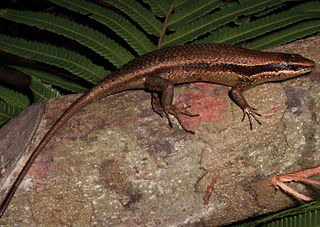 W
WEutropis multicarinata is a species of skink found in the Philippines.
 W
WThe forest gecko is a species of gecko. Granulatus refers to the granular texture of the skin. Its Māori name is moko pirirākau. It is endemic to New Zealand, found in all areas except the Far North, Marlborough, and Canterbury.
 W
WForsten's tortoise is a species of tortoise in the family Testudinidae. Forsten's tortoise is one of three tortoise species placed in the genus Indotestudo, the others being the elongated tortoise, and the Travancore tortoise.
 W
WGehyra australis, the Australian house gecko, northern dtella or top-end dtella, is a species of gecko native to northern and eastern Australia. It is also widespread in Indonesia, alongside common house geckos and four-clawed geckos.
 W
WGonocephalus sophiae, Negros forest dragon or Philippine forest dragon is a species of lizards endemic to the Philippines. It is found between 0 and 1200 m above sea level on the islands of Negros, Mindanao and Panay, and possibly on Siargao, Luzon, Samar, Palawan and the Calamian Islands. The species is oviparous, and lays eggs in small holes dug in the banks of forest rivers. It is often confused with G. interruptus and G. semperi and therefore remains poorly characterized. Adults reach a total length of ca. 30 cm and feed mostly on insects.
 W
WThe grand skink is an endangered species of large skink endemic to the central Otago region of New Zealand.
 W
WThe Guinea lidless skink is a species of lidless skinks in the family Scincidae. The species is found on Príncipe, Ilhéu das Rolas, and São Tomé.
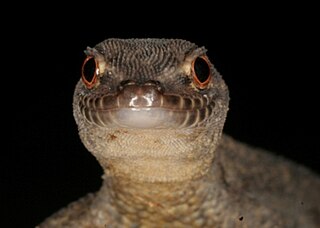 W
WGymnodactylus darwinii is a species of lizard in the family Phyllodactylidae. The specific name, darwini, is in honor of English naturalist Charles Darwin. It is endemic to eastern Brazil.
 W
WHemidactylus brookii, commonly known as Brooke's house gecko or spotted house gecko, is a widespread species of gecko.
 W
WHeteronotia binoei, also known as the prickly gecko or Bynoe's gecko, is a species of lizard in the family Gekkonidae. The species is endemic to Australia. One of Australia's least habitat-specific geckos, it occurs naturally across much of the country, and has also established in areas where it does not occur naturally, such as urban Perth, Western Australia. It is dark brown to reddish brown, depending on the colour of the ground upon which it lives. There are irregular light bands with dark edges along its back.
 W
WThe Jamaican iguana is a large species of lizard in the family Iguanidae. The species is endemic to Jamaica. It is the largest native land animal in Jamaica, and is critically endangered, even considered extinct between 1948 and 1990. Once found throughout Jamaica and on the offshore islets Great Goat Island and Little Goat Island, it is now confined to the forests of the Hellshire Hills.
 W
WKendall's rock gecko is a species of gecko, a lizard in the family Gekkonidae. The species is endemic to Borneo and the Malaysian peninsula.
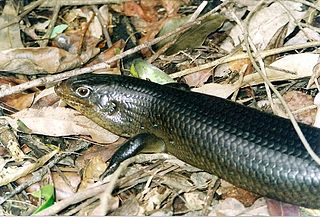 W
WThe land mullet is one of the largest members of the skink family (Scincidae).
 W
WLipinia pulchella, known commonly as the yellow-striped slender tree skink or beautiful lipinia, is a species of skink, a lizard in the family Scincidae. The species is endemic to the Philippines.
 W
WLuperosaurus cumingii, also known as the Philippine wolf gecko or Cuming's flapped-legged gecko, is a species of gecko. It is endemic to southern Luzon in the Philippines.
 W
WMalayotyphlops ruficaudus, commonly known as brown blind snake or red-headed worm snake, is a species of snake in the Typhlopidae family. It is endemic to the Philippines, where it is found on the islands of Luzon, Tablas and Marinduque.
 W
WThe Mekong snail-eating turtle is a species of turtle in the family Geoemydidae. It was monotypic within the genus Malayemys until Brophy reevaluated Malayemys macrocephala, which has been long time considered to be a synonym of M. subtrijuga.
 W
WMetlapilcoatlus nummifer, commonly known as Mexican jumping pitviper or jumping viper, is a venomous pit viper species endemic to Mexico.
 W
WMicrolophus thoracicus, the Tschudi's Pacific iguana, is a species of lava lizard endemic to Peru.
 W
WMicrolophus tigris, the tiger Pacific iguana, is a species of lava lizard endemic to Peru.
 W
WThe Oriental leaf-toed gecko, also known as Bowring's gecko, Sikkimese dark-spotted gecko, or Asian smooth gecko, is a species of gecko endemic to East Asia.
 W
WOtosaurus cumingi, commonly called Cuming's sphenomorphus or the Luzon giant forest skink, is a species of skink, a lizard in the family Scincidae. The species is endemic to the Philippines.
 W
WOxyrhopus melanogenys, commonly known as Tschudi's false coral snake, is a colubrid snake species found in the northern part of South America.
 W
WThe perentie is the largest monitor lizard or goanna native to Australia, and the fourth-largest living lizard on earth, after the Komodo dragon, Asian water monitor, and crocodile monitor. Found west of the Great Dividing Range in the arid areas of Australia, it is rarely seen because of its shyness and the remoteness of much of its range from human habitation. The species is considered to be a least-concern species according to the International Union for Conservation of Nature.
 W
WPolychrus gutturosus, also known as Berthold's bush anole or monkey tailed anole, is a species of lizard found in tropical Central and South America. It is sometimes referred to as a "forest iguana". It lives in forests and jungles from Honduras to Ecuador. It can reach up to 70 cm (2.3 ft) in total length, including its very long tail, and males are considerably smaller than females. This insectivorous lizard is a climbing species that can often be seen holding onto branches. It can even hold on with its hind legs, though it moves slowly that way.
 W
WThe pink-tongued skink is a species of lizard in the family Scincidae. C. gerrardii is endemic to Australia, where it is also called commonly the pink-tongued lizard. As suggested by these common names, its distinguishing characteristic is a pink tongue as opposed to the blue tongue of lizards of the closely related genus Tiliqua.
 W
WThe regal horned lizard is a horned lizard species native to Mexico and the Southwest United States.
 W
WThe rhinoceros chameleon is a species of chameleon that gets its common name from its horn-like nose which is most prominent in males. It is endemic to dry forests in Madagascar.
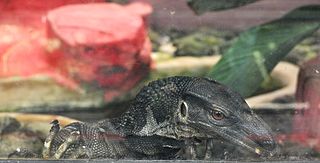 W
WThe black roughneck monitor, Varanus rudicollis, is a species of monitor lizard found in Southeast Asian countries of Thailand, Burma, and Malaysia. It is also found in Indonesia on Sumatra and islands of the Riau Archipelago It is sometimes known simply as the roughneck monitor. In Thailand is called h̄èā cĥāng.
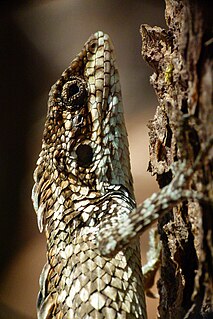 W
WSalea horsfieldii, commonly known as Horsfield's spiny lizard or the Nilgiri salea, is a species of lizard in the family Agamidae. The species is endemic to the Nilgiri Hills of India. It is found mainly in the high altitude grassy hills. A related species, Salea anamallayana, is found in the grassy hills of the Anaimalai Hills.
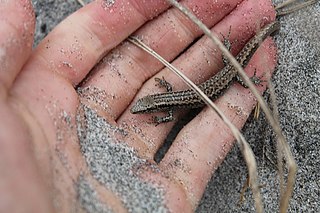 W
WThe shore skink, also commonly known as the short-tailed skink, Smith's ground skink, Smith's moco, and Smith's skink, is a species of lizard in the family Scincidae. The species is native to the northern half of the North Island of New Zealand.
 W
WSphaerodactylus nigropunctatus, also known as the black-spotted least gecko or three-banded sphaero, is a species of lizard in the family Sphaerodactylidae. It is found in the Bahamas and Cuba.
 W
WSphaerodactylus richardsonii, also known commonly as Richardson's least gecko or the northern Jamaica banded sphaero, is a small species of lizard in the family Sphaerodactylidae. The species is endemic to Jamaica.
 W
WSphenomorphus fasciatus , the banded sphenomorphus, is a species of skink endemic to the Philippines. It is oviparous and grows to about 70 mm (2.8 in) in snout–vent length.
 W
WThe spotted skink, sometimes called the ocellated cool-skink or ocellated skink, is a skink endemic to Tasmania, Australia. It is a ground-dwelling, viviparous species, usually found in rocky habitats, and widespread in the northern and eastern parts of the state, as well as in the eastern Bass Strait islands. It is often found at Arthurs Lake in the Central Highlands of Tasmania.
 W
WThe spiny whorltail iguana is a species of lizard of the Tropiduridae family, found in the state of Cusco, southeast Peru. It was first described by Johann Jakob von Tschudi in 1845.
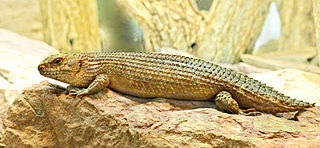 W
WEgernia stokesii is a gregarious species of lizard of the Scincidae family. This diurnal species is endemic to Australia, and is also known as the Gidgee skink, Spiny-tailed skink, Stokes' skink and Stokes' Egernia. The species forms stable, long-term social aggregations, much like the social groups seen in mammalian and avian species. This characteristic is rarely found in the Squamata order, but is widespread within the Australian subfamily of Egerniinae skinks. Populations of E. stokesii are widely distributed, but fragmented, and occur in semi-arid environments. There are three recognised subspecies. The conservation status for the species is listed as least concern, however, one subspecies is listed as endangered.
 W
WTrachylepis maculilabris is a species of skink. Commonly referred to as the speckle-lipped skink or speckle-lipped mabuya. It can be found in West Africa.
 W
WWoodworthia maculata, also known as the New Zealand common gecko or Raukawa gecko, is a species in the family Diplodactylidae. The specific name maculata means "speckled".
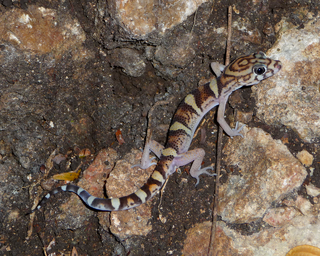 W
WThe Yucatán banded gecko is a species of geckos found in Mexico, Guatemala, and Belize.